Subdividing Land and CGT Implications
VerifiedAdded on 2020/03/16
|11
|3054
|78
AI Summary
This assignment focuses on the capital gains tax (CGT) consequences of subdividing land in Australia. It delves into determining the cost base for each subdivided block, analyzing the holding period, and calculating assessable income based on a hypothetical scenario involving land subdivision and construction. The analysis emphasizes the application of relevant Australian Taxation Office (ATO) guidelines and principles.
Contribute Materials
Your contribution can guide someone’s learning journey. Share your
documents today.
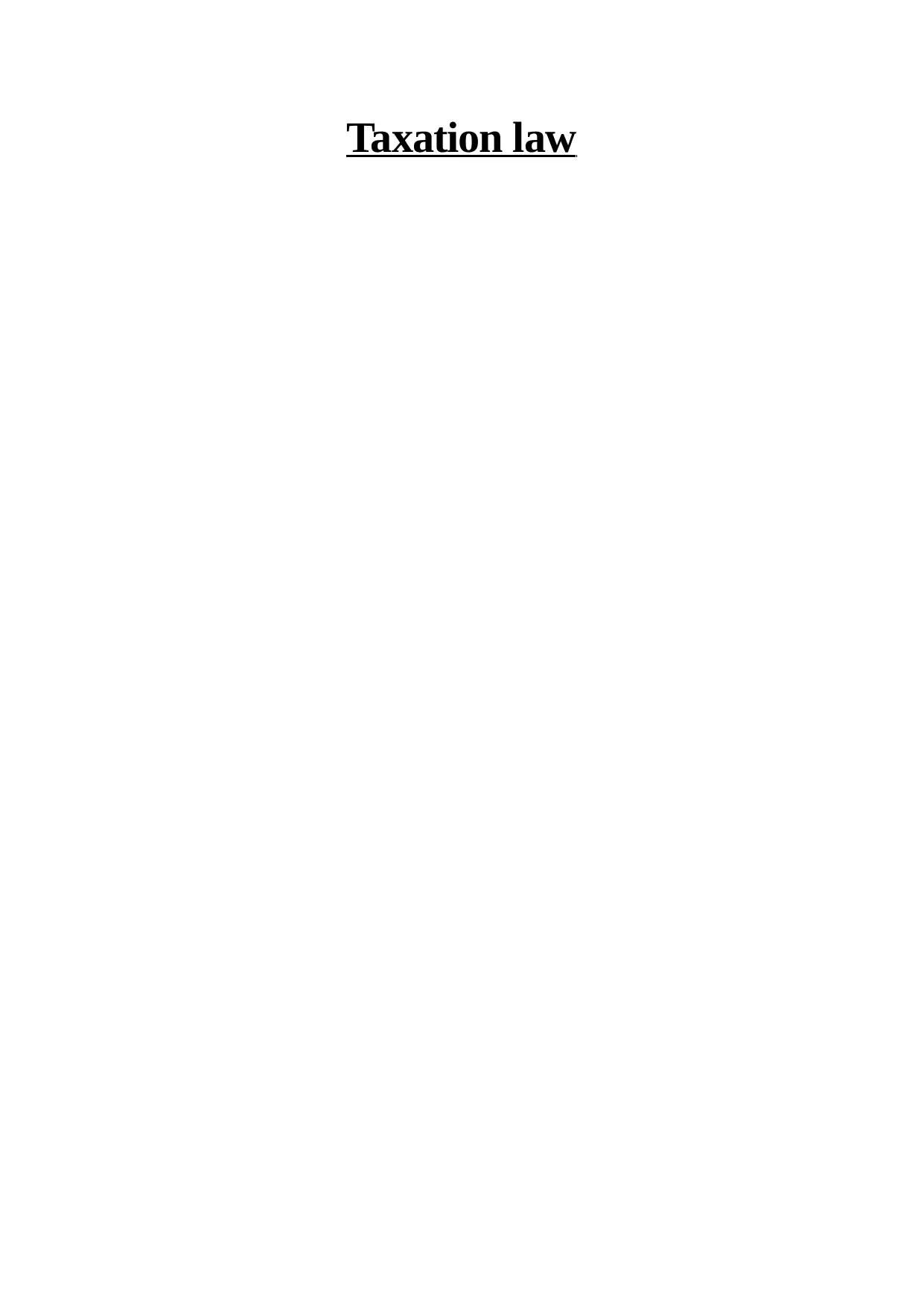
Taxation law
Secure Best Marks with AI Grader
Need help grading? Try our AI Grader for instant feedback on your assignments.
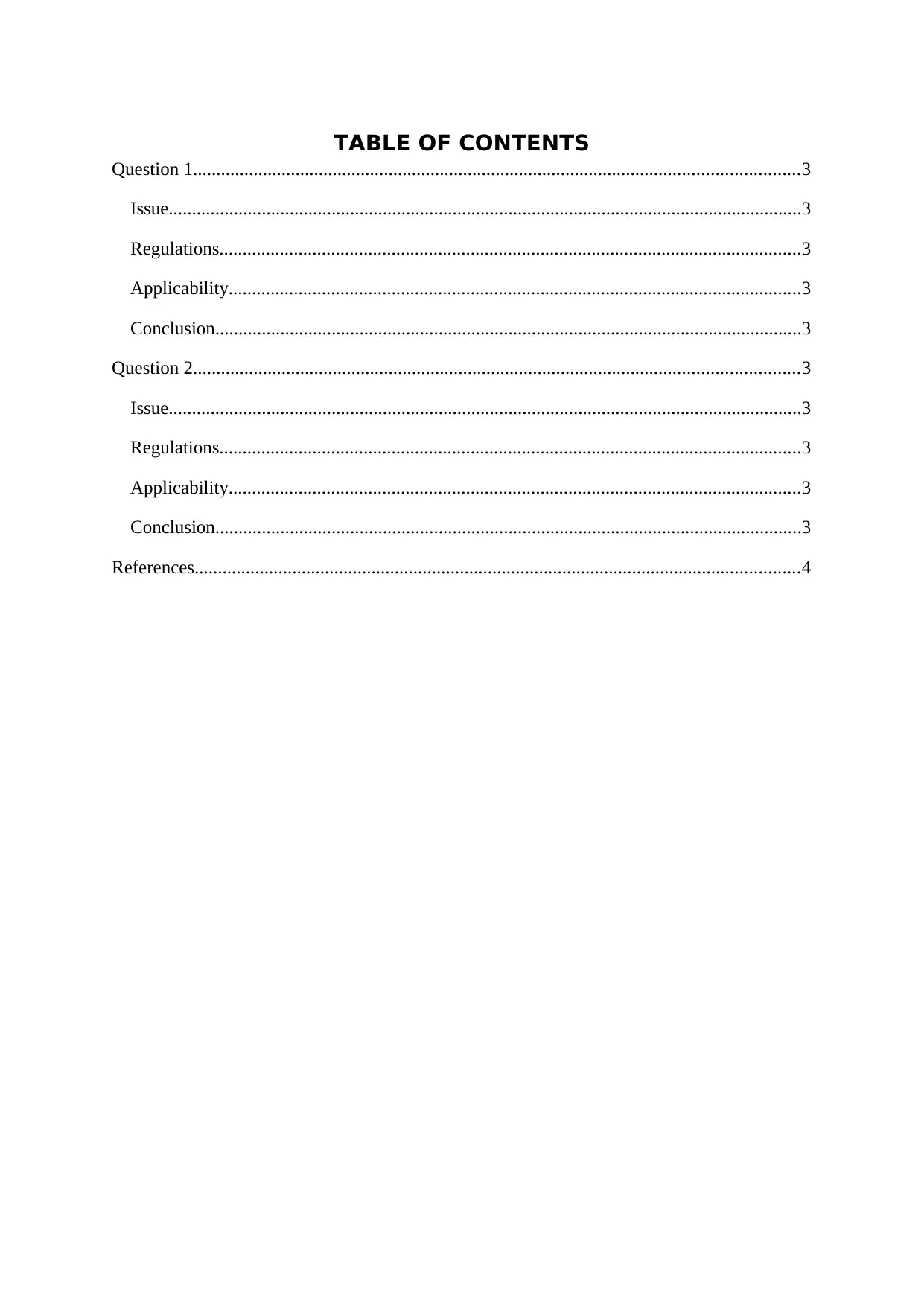
TABLE OF CONTENTS
Question 1..................................................................................................................................3
Issue........................................................................................................................................3
Regulations.............................................................................................................................3
Applicability...........................................................................................................................3
Conclusion..............................................................................................................................3
Question 2..................................................................................................................................3
Issue........................................................................................................................................3
Regulations.............................................................................................................................3
Applicability...........................................................................................................................3
Conclusion..............................................................................................................................3
References..................................................................................................................................4
Question 1..................................................................................................................................3
Issue........................................................................................................................................3
Regulations.............................................................................................................................3
Applicability...........................................................................................................................3
Conclusion..............................................................................................................................3
Question 2..................................................................................................................................3
Issue........................................................................................................................................3
Regulations.............................................................................................................................3
Applicability...........................................................................................................................3
Conclusion..............................................................................................................................3
References..................................................................................................................................4
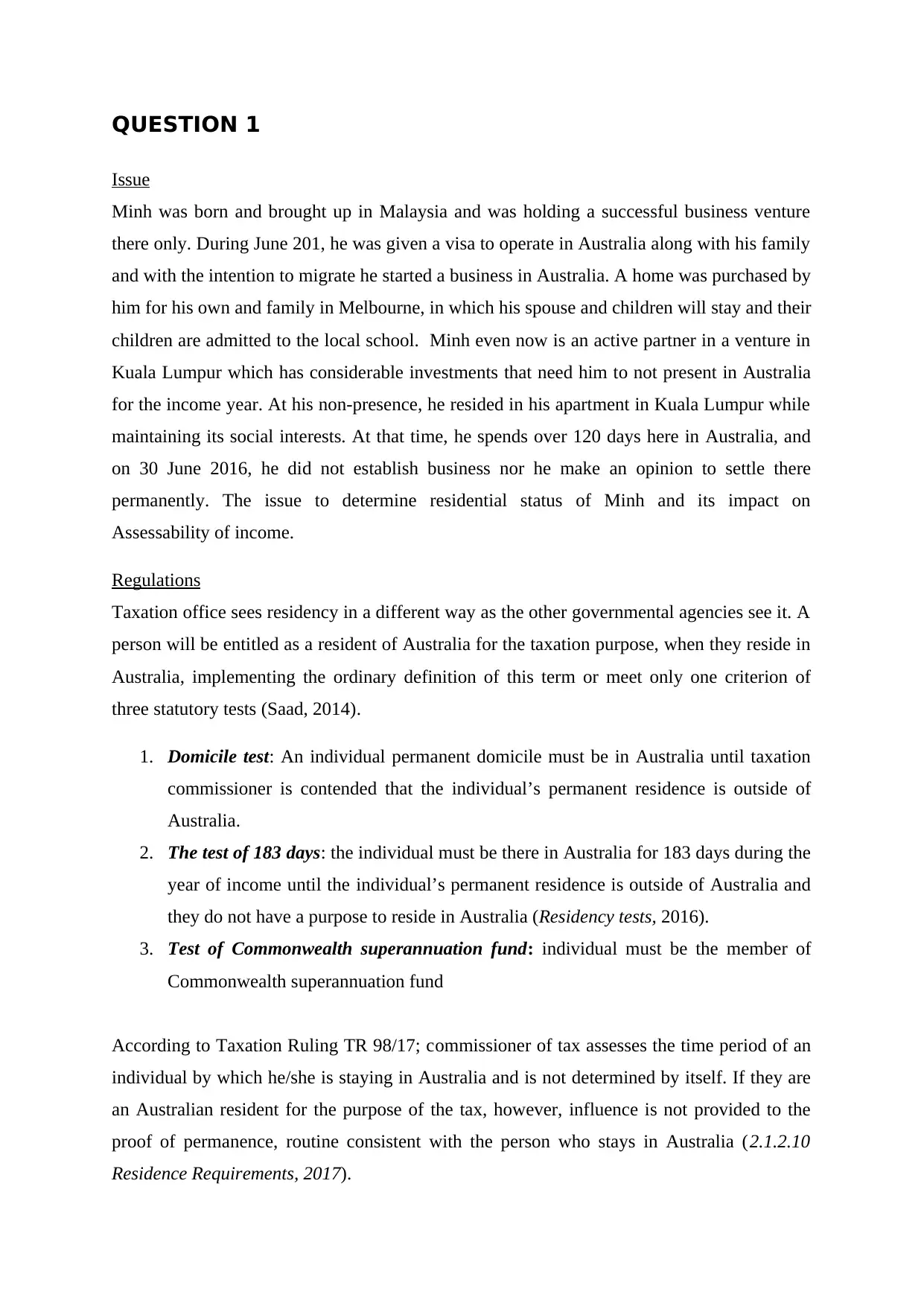
QUESTION 1
Issue
Minh was born and brought up in Malaysia and was holding a successful business venture
there only. During June 201, he was given a visa to operate in Australia along with his family
and with the intention to migrate he started a business in Australia. A home was purchased by
him for his own and family in Melbourne, in which his spouse and children will stay and their
children are admitted to the local school. Minh even now is an active partner in a venture in
Kuala Lumpur which has considerable investments that need him to not present in Australia
for the income year. At his non-presence, he resided in his apartment in Kuala Lumpur while
maintaining its social interests. At that time, he spends over 120 days here in Australia, and
on 30 June 2016, he did not establish business nor he make an opinion to settle there
permanently. The issue to determine residential status of Minh and its impact on
Assessability of income.
Regulations
Taxation office sees residency in a different way as the other governmental agencies see it. A
person will be entitled as a resident of Australia for the taxation purpose, when they reside in
Australia, implementing the ordinary definition of this term or meet only one criterion of
three statutory tests (Saad, 2014).
1. Domicile test: An individual permanent domicile must be in Australia until taxation
commissioner is contended that the individual’s permanent residence is outside of
Australia.
2. The test of 183 days: the individual must be there in Australia for 183 days during the
year of income until the individual’s permanent residence is outside of Australia and
they do not have a purpose to reside in Australia (Residency tests, 2016).
3. Test of Commonwealth superannuation fund: individual must be the member of
Commonwealth superannuation fund
According to Taxation Ruling TR 98/17; commissioner of tax assesses the time period of an
individual by which he/she is staying in Australia and is not determined by itself. If they are
an Australian resident for the purpose of the tax, however, influence is not provided to the
proof of permanence, routine consistent with the person who stays in Australia (2.1.2.10
Residence Requirements, 2017).
Issue
Minh was born and brought up in Malaysia and was holding a successful business venture
there only. During June 201, he was given a visa to operate in Australia along with his family
and with the intention to migrate he started a business in Australia. A home was purchased by
him for his own and family in Melbourne, in which his spouse and children will stay and their
children are admitted to the local school. Minh even now is an active partner in a venture in
Kuala Lumpur which has considerable investments that need him to not present in Australia
for the income year. At his non-presence, he resided in his apartment in Kuala Lumpur while
maintaining its social interests. At that time, he spends over 120 days here in Australia, and
on 30 June 2016, he did not establish business nor he make an opinion to settle there
permanently. The issue to determine residential status of Minh and its impact on
Assessability of income.
Regulations
Taxation office sees residency in a different way as the other governmental agencies see it. A
person will be entitled as a resident of Australia for the taxation purpose, when they reside in
Australia, implementing the ordinary definition of this term or meet only one criterion of
three statutory tests (Saad, 2014).
1. Domicile test: An individual permanent domicile must be in Australia until taxation
commissioner is contended that the individual’s permanent residence is outside of
Australia.
2. The test of 183 days: the individual must be there in Australia for 183 days during the
year of income until the individual’s permanent residence is outside of Australia and
they do not have a purpose to reside in Australia (Residency tests, 2016).
3. Test of Commonwealth superannuation fund: individual must be the member of
Commonwealth superannuation fund
According to Taxation Ruling TR 98/17; commissioner of tax assesses the time period of an
individual by which he/she is staying in Australia and is not determined by itself. If they are
an Australian resident for the purpose of the tax, however, influence is not provided to the
proof of permanence, routine consistent with the person who stays in Australia (2.1.2.10
Residence Requirements, 2017).
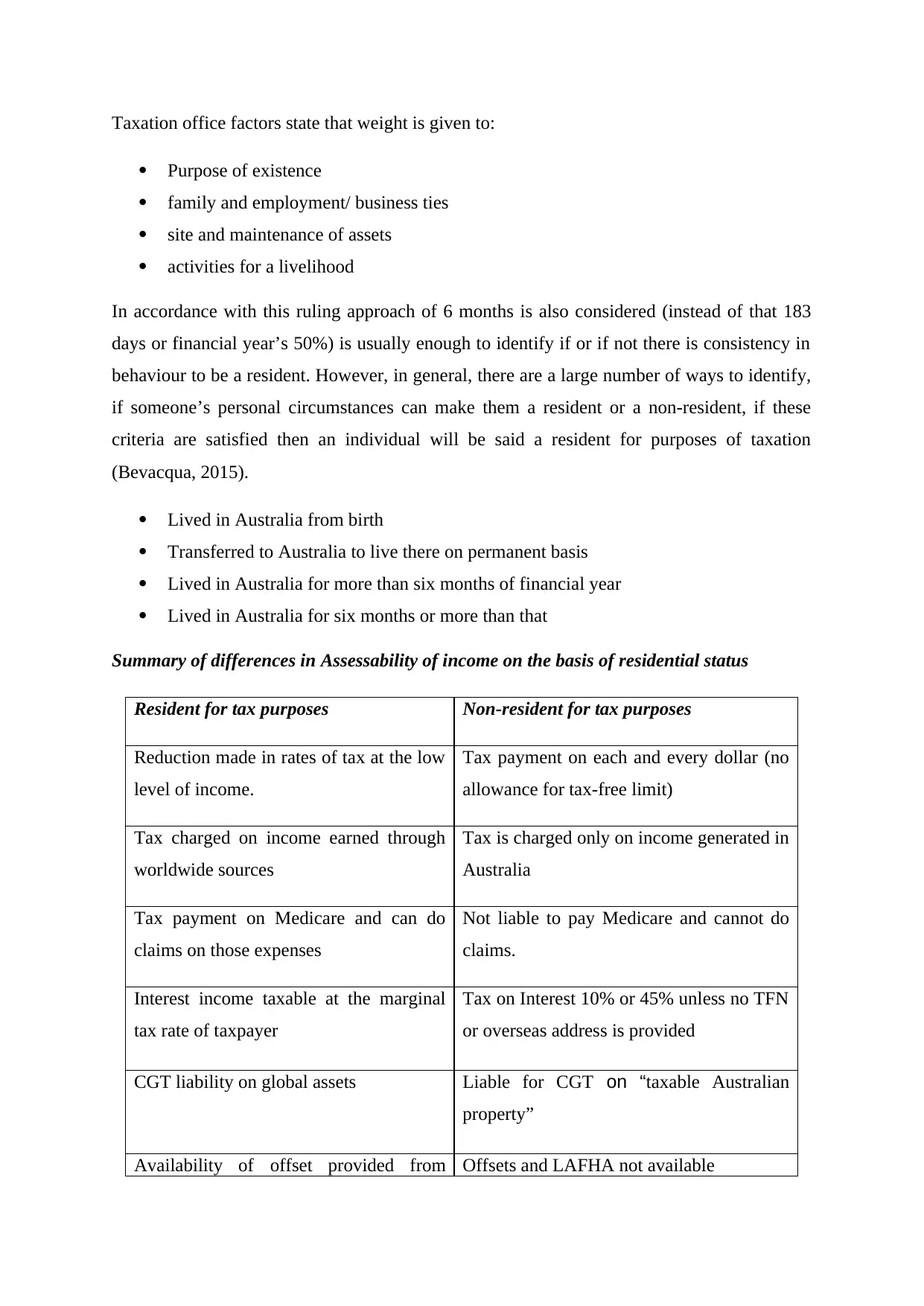
Taxation office factors state that weight is given to:
Purpose of existence
family and employment/ business ties
site and maintenance of assets
activities for a livelihood
In accordance with this ruling approach of 6 months is also considered (instead of that 183
days or financial year’s 50%) is usually enough to identify if or if not there is consistency in
behaviour to be a resident. However, in general, there are a large number of ways to identify,
if someone’s personal circumstances can make them a resident or a non-resident, if these
criteria are satisfied then an individual will be said a resident for purposes of taxation
(Bevacqua, 2015).
Lived in Australia from birth
Transferred to Australia to live there on permanent basis
Lived in Australia for more than six months of financial year
Lived in Australia for six months or more than that
Summary of differences in Assessability of income on the basis of residential status
Resident for tax purposes Non-resident for tax purposes
Reduction made in rates of tax at the low
level of income.
Tax payment on each and every dollar (no
allowance for tax-free limit)
Tax charged on income earned through
worldwide sources
Tax is charged only on income generated in
Australia
Tax payment on Medicare and can do
claims on those expenses
Not liable to pay Medicare and cannot do
claims.
Interest income taxable at the marginal
tax rate of taxpayer
Tax on Interest 10% or 45% unless no TFN
or overseas address is provided
CGT liability on global assets Liable for CGT on “taxable Australian
property”
Availability of offset provided from Offsets and LAFHA not available
Purpose of existence
family and employment/ business ties
site and maintenance of assets
activities for a livelihood
In accordance with this ruling approach of 6 months is also considered (instead of that 183
days or financial year’s 50%) is usually enough to identify if or if not there is consistency in
behaviour to be a resident. However, in general, there are a large number of ways to identify,
if someone’s personal circumstances can make them a resident or a non-resident, if these
criteria are satisfied then an individual will be said a resident for purposes of taxation
(Bevacqua, 2015).
Lived in Australia from birth
Transferred to Australia to live there on permanent basis
Lived in Australia for more than six months of financial year
Lived in Australia for six months or more than that
Summary of differences in Assessability of income on the basis of residential status
Resident for tax purposes Non-resident for tax purposes
Reduction made in rates of tax at the low
level of income.
Tax payment on each and every dollar (no
allowance for tax-free limit)
Tax charged on income earned through
worldwide sources
Tax is charged only on income generated in
Australia
Tax payment on Medicare and can do
claims on those expenses
Not liable to pay Medicare and cannot do
claims.
Interest income taxable at the marginal
tax rate of taxpayer
Tax on Interest 10% or 45% unless no TFN
or overseas address is provided
CGT liability on global assets Liable for CGT on “taxable Australian
property”
Availability of offset provided from Offsets and LAFHA not available
Secure Best Marks with AI Grader
Need help grading? Try our AI Grader for instant feedback on your assignments.
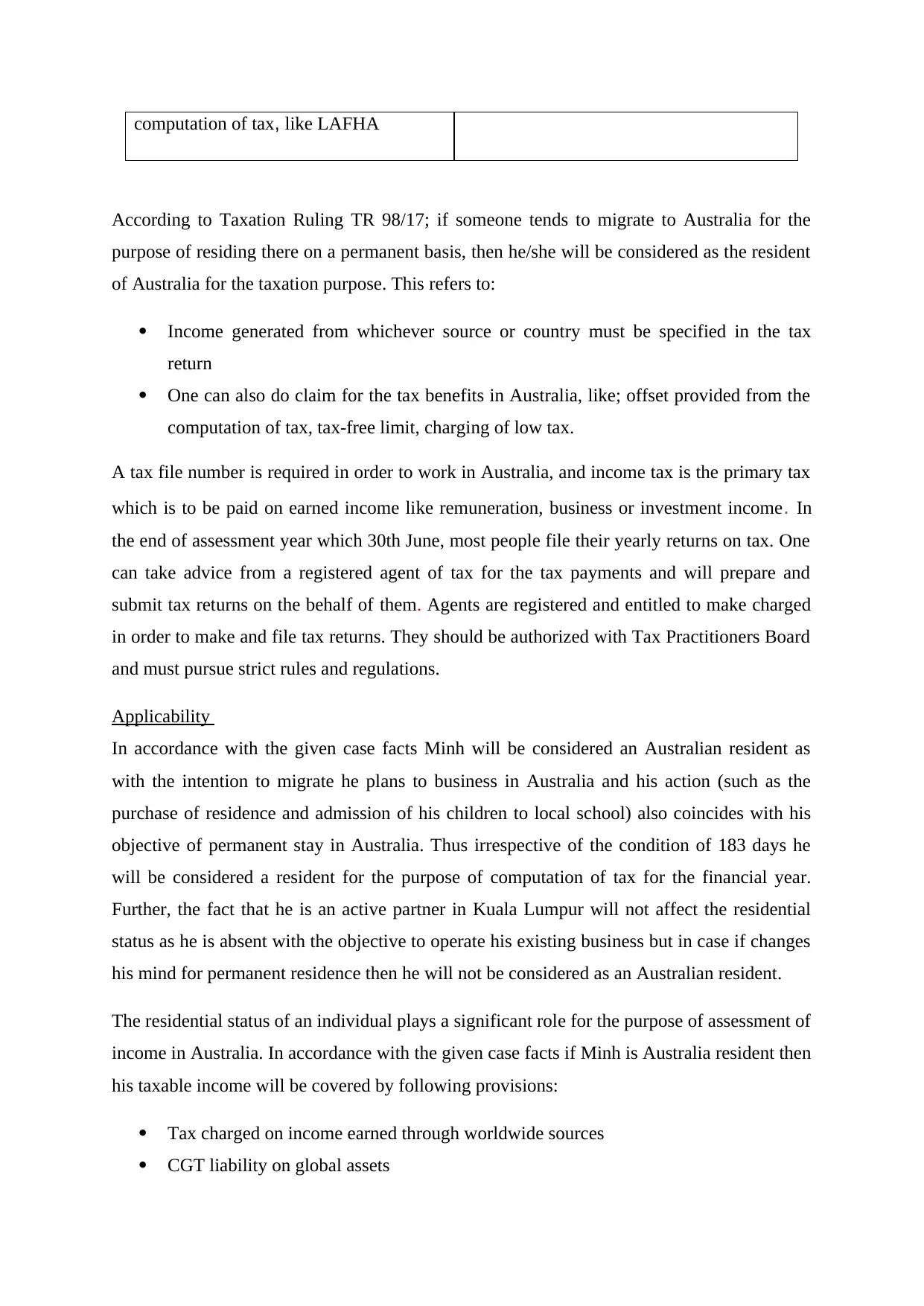
computation of tax, like LAFHA
According to Taxation Ruling TR 98/17; if someone tends to migrate to Australia for the
purpose of residing there on a permanent basis, then he/she will be considered as the resident
of Australia for the taxation purpose. This refers to:
Income generated from whichever source or country must be specified in the tax
return
One can also do claim for the tax benefits in Australia, like; offset provided from the
computation of tax, tax-free limit, charging of low tax.
A tax file number is required in order to work in Australia, and income tax is the primary tax
which is to be paid on earned income like remuneration, business or investment income. In
the end of assessment year which 30th June, most people file their yearly returns on tax. One
can take advice from a registered agent of tax for the tax payments and will prepare and
submit tax returns on the behalf of them. Agents are registered and entitled to make charged
in order to make and file tax returns. They should be authorized with Tax Practitioners Board
and must pursue strict rules and regulations.
Applicability
In accordance with the given case facts Minh will be considered an Australian resident as
with the intention to migrate he plans to business in Australia and his action (such as the
purchase of residence and admission of his children to local school) also coincides with his
objective of permanent stay in Australia. Thus irrespective of the condition of 183 days he
will be considered a resident for the purpose of computation of tax for the financial year.
Further, the fact that he is an active partner in Kuala Lumpur will not affect the residential
status as he is absent with the objective to operate his existing business but in case if changes
his mind for permanent residence then he will not be considered as an Australian resident.
The residential status of an individual plays a significant role for the purpose of assessment of
income in Australia. In accordance with the given case facts if Minh is Australia resident then
his taxable income will be covered by following provisions:
Tax charged on income earned through worldwide sources
CGT liability on global assets
According to Taxation Ruling TR 98/17; if someone tends to migrate to Australia for the
purpose of residing there on a permanent basis, then he/she will be considered as the resident
of Australia for the taxation purpose. This refers to:
Income generated from whichever source or country must be specified in the tax
return
One can also do claim for the tax benefits in Australia, like; offset provided from the
computation of tax, tax-free limit, charging of low tax.
A tax file number is required in order to work in Australia, and income tax is the primary tax
which is to be paid on earned income like remuneration, business or investment income. In
the end of assessment year which 30th June, most people file their yearly returns on tax. One
can take advice from a registered agent of tax for the tax payments and will prepare and
submit tax returns on the behalf of them. Agents are registered and entitled to make charged
in order to make and file tax returns. They should be authorized with Tax Practitioners Board
and must pursue strict rules and regulations.
Applicability
In accordance with the given case facts Minh will be considered an Australian resident as
with the intention to migrate he plans to business in Australia and his action (such as the
purchase of residence and admission of his children to local school) also coincides with his
objective of permanent stay in Australia. Thus irrespective of the condition of 183 days he
will be considered a resident for the purpose of computation of tax for the financial year.
Further, the fact that he is an active partner in Kuala Lumpur will not affect the residential
status as he is absent with the objective to operate his existing business but in case if changes
his mind for permanent residence then he will not be considered as an Australian resident.
The residential status of an individual plays a significant role for the purpose of assessment of
income in Australia. In accordance with the given case facts if Minh is Australia resident then
his taxable income will be covered by following provisions:
Tax charged on income earned through worldwide sources
CGT liability on global assets
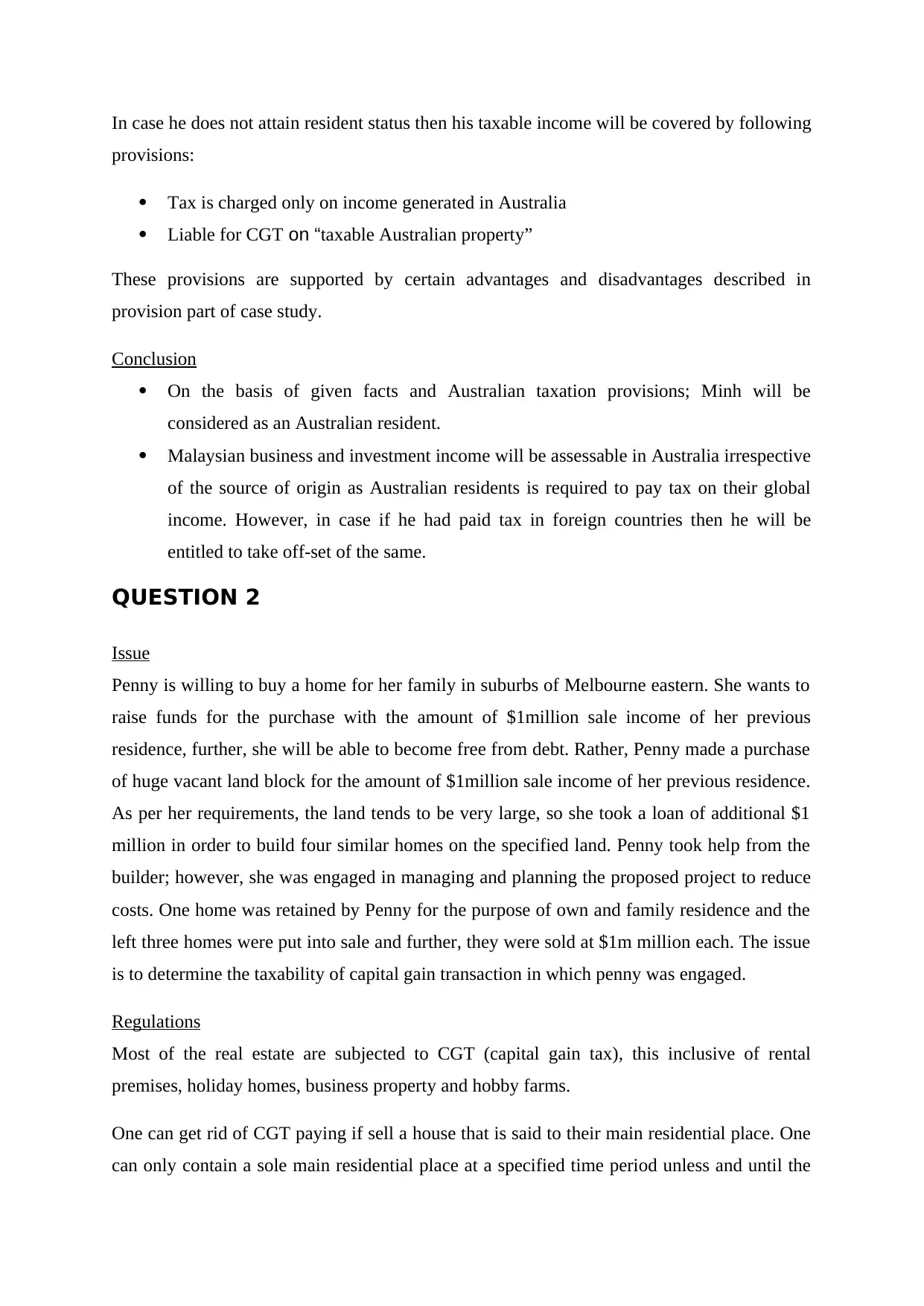
In case he does not attain resident status then his taxable income will be covered by following
provisions:
Tax is charged only on income generated in Australia
Liable for CGT on “taxable Australian property”
These provisions are supported by certain advantages and disadvantages described in
provision part of case study.
Conclusion
On the basis of given facts and Australian taxation provisions; Minh will be
considered as an Australian resident.
Malaysian business and investment income will be assessable in Australia irrespective
of the source of origin as Australian residents is required to pay tax on their global
income. However, in case if he had paid tax in foreign countries then he will be
entitled to take off-set of the same.
QUESTION 2
Issue
Penny is willing to buy a home for her family in suburbs of Melbourne eastern. She wants to
raise funds for the purchase with the amount of $1million sale income of her previous
residence, further, she will be able to become free from debt. Rather, Penny made a purchase
of huge vacant land block for the amount of $1million sale income of her previous residence.
As per her requirements, the land tends to be very large, so she took a loan of additional $1
million in order to build four similar homes on the specified land. Penny took help from the
builder; however, she was engaged in managing and planning the proposed project to reduce
costs. One home was retained by Penny for the purpose of own and family residence and the
left three homes were put into sale and further, they were sold at $1m million each. The issue
is to determine the taxability of capital gain transaction in which penny was engaged.
Regulations
Most of the real estate are subjected to CGT (capital gain tax), this inclusive of rental
premises, holiday homes, business property and hobby farms.
One can get rid of CGT paying if sell a house that is said to their main residential place. One
can only contain a sole main residential place at a specified time period unless and until the
provisions:
Tax is charged only on income generated in Australia
Liable for CGT on “taxable Australian property”
These provisions are supported by certain advantages and disadvantages described in
provision part of case study.
Conclusion
On the basis of given facts and Australian taxation provisions; Minh will be
considered as an Australian resident.
Malaysian business and investment income will be assessable in Australia irrespective
of the source of origin as Australian residents is required to pay tax on their global
income. However, in case if he had paid tax in foreign countries then he will be
entitled to take off-set of the same.
QUESTION 2
Issue
Penny is willing to buy a home for her family in suburbs of Melbourne eastern. She wants to
raise funds for the purchase with the amount of $1million sale income of her previous
residence, further, she will be able to become free from debt. Rather, Penny made a purchase
of huge vacant land block for the amount of $1million sale income of her previous residence.
As per her requirements, the land tends to be very large, so she took a loan of additional $1
million in order to build four similar homes on the specified land. Penny took help from the
builder; however, she was engaged in managing and planning the proposed project to reduce
costs. One home was retained by Penny for the purpose of own and family residence and the
left three homes were put into sale and further, they were sold at $1m million each. The issue
is to determine the taxability of capital gain transaction in which penny was engaged.
Regulations
Most of the real estate are subjected to CGT (capital gain tax), this inclusive of rental
premises, holiday homes, business property and hobby farms.
One can get rid of CGT paying if sell a house that is said to their main residential place. One
can only contain a sole main residential place at a specified time period unless and until the
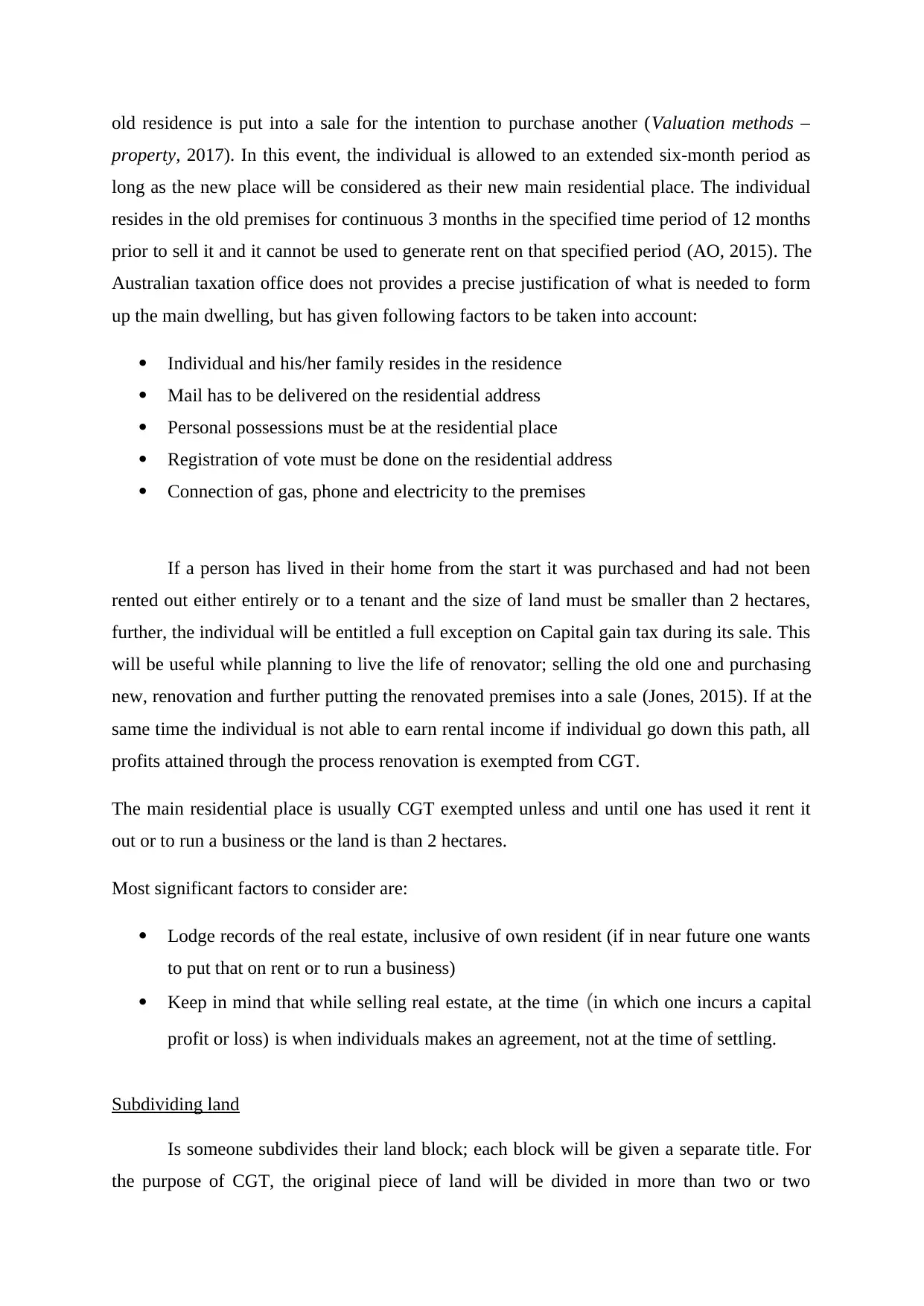
old residence is put into a sale for the intention to purchase another (Valuation methods –
property, 2017). In this event, the individual is allowed to an extended six-month period as
long as the new place will be considered as their new main residential place. The individual
resides in the old premises for continuous 3 months in the specified time period of 12 months
prior to sell it and it cannot be used to generate rent on that specified period (AO, 2015). The
Australian taxation office does not provides a precise justification of what is needed to form
up the main dwelling, but has given following factors to be taken into account:
Individual and his/her family resides in the residence
Mail has to be delivered on the residential address
Personal possessions must be at the residential place
Registration of vote must be done on the residential address
Connection of gas, phone and electricity to the premises
If a person has lived in their home from the start it was purchased and had not been
rented out either entirely or to a tenant and the size of land must be smaller than 2 hectares,
further, the individual will be entitled a full exception on Capital gain tax during its sale. This
will be useful while planning to live the life of renovator; selling the old one and purchasing
new, renovation and further putting the renovated premises into a sale (Jones, 2015). If at the
same time the individual is not able to earn rental income if individual go down this path, all
profits attained through the process renovation is exempted from CGT.
The main residential place is usually CGT exempted unless and until one has used it rent it
out or to run a business or the land is than 2 hectares.
Most significant factors to consider are:
Lodge records of the real estate, inclusive of own resident (if in near future one wants
to put that on rent or to run a business)
Keep in mind that while selling real estate, at the time (in which one incurs a capital
profit or loss) is when individuals makes an agreement, not at the time of settling.
Subdividing land
Is someone subdivides their land block; each block will be given a separate title. For
the purpose of CGT, the original piece of land will be divided in more than two or two
property, 2017). In this event, the individual is allowed to an extended six-month period as
long as the new place will be considered as their new main residential place. The individual
resides in the old premises for continuous 3 months in the specified time period of 12 months
prior to sell it and it cannot be used to generate rent on that specified period (AO, 2015). The
Australian taxation office does not provides a precise justification of what is needed to form
up the main dwelling, but has given following factors to be taken into account:
Individual and his/her family resides in the residence
Mail has to be delivered on the residential address
Personal possessions must be at the residential place
Registration of vote must be done on the residential address
Connection of gas, phone and electricity to the premises
If a person has lived in their home from the start it was purchased and had not been
rented out either entirely or to a tenant and the size of land must be smaller than 2 hectares,
further, the individual will be entitled a full exception on Capital gain tax during its sale. This
will be useful while planning to live the life of renovator; selling the old one and purchasing
new, renovation and further putting the renovated premises into a sale (Jones, 2015). If at the
same time the individual is not able to earn rental income if individual go down this path, all
profits attained through the process renovation is exempted from CGT.
The main residential place is usually CGT exempted unless and until one has used it rent it
out or to run a business or the land is than 2 hectares.
Most significant factors to consider are:
Lodge records of the real estate, inclusive of own resident (if in near future one wants
to put that on rent or to run a business)
Keep in mind that while selling real estate, at the time (in which one incurs a capital
profit or loss) is when individuals makes an agreement, not at the time of settling.
Subdividing land
Is someone subdivides their land block; each block will be given a separate title. For
the purpose of CGT, the original piece of land will be divided in more than two or two
Paraphrase This Document
Need a fresh take? Get an instant paraphrase of this document with our AI Paraphraser
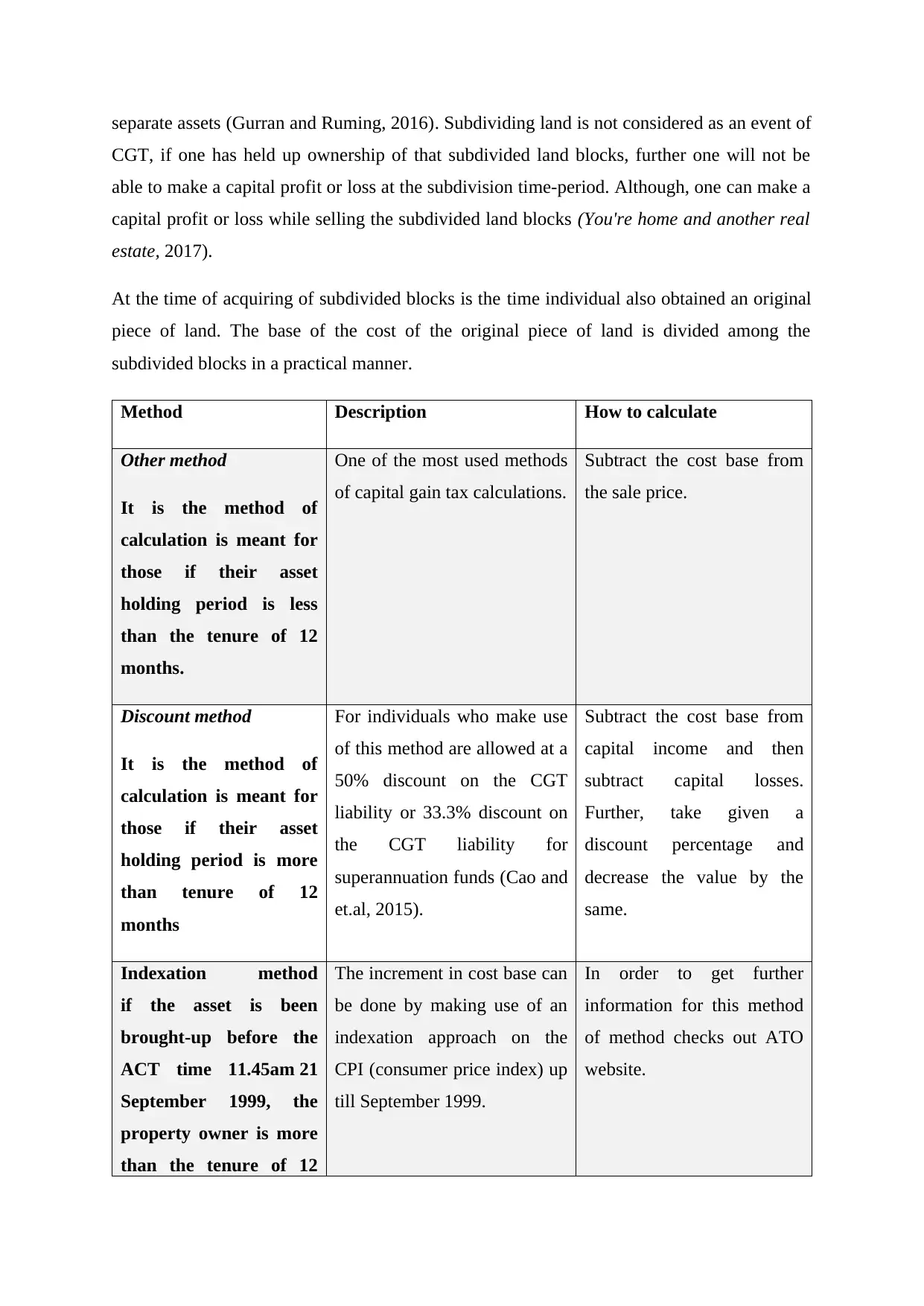
separate assets (Gurran and Ruming, 2016). Subdividing land is not considered as an event of
CGT, if one has held up ownership of that subdivided land blocks, further one will not be
able to make a capital profit or loss at the subdivision time-period. Although, one can make a
capital profit or loss while selling the subdivided land blocks (You're home and another real
estate, 2017).
At the time of acquiring of subdivided blocks is the time individual also obtained an original
piece of land. The base of the cost of the original piece of land is divided among the
subdivided blocks in a practical manner.
Method Description How to calculate
Other method
It is the method of
calculation is meant for
those if their asset
holding period is less
than the tenure of 12
months.
One of the most used methods
of capital gain tax calculations.
Subtract the cost base from
the sale price.
Discount method
It is the method of
calculation is meant for
those if their asset
holding period is more
than tenure of 12
months
For individuals who make use
of this method are allowed at a
50% discount on the CGT
liability or 33.3% discount on
the CGT liability for
superannuation funds (Cao and
et.al, 2015).
Subtract the cost base from
capital income and then
subtract capital losses.
Further, take given a
discount percentage and
decrease the value by the
same.
Indexation method
if the asset is been
brought-up before the
ACT time 11.45am 21
September 1999, the
property owner is more
than the tenure of 12
The increment in cost base can
be done by making use of an
indexation approach on the
CPI (consumer price index) up
till September 1999.
In order to get further
information for this method
of method checks out ATO
website.
CGT, if one has held up ownership of that subdivided land blocks, further one will not be
able to make a capital profit or loss at the subdivision time-period. Although, one can make a
capital profit or loss while selling the subdivided land blocks (You're home and another real
estate, 2017).
At the time of acquiring of subdivided blocks is the time individual also obtained an original
piece of land. The base of the cost of the original piece of land is divided among the
subdivided blocks in a practical manner.
Method Description How to calculate
Other method
It is the method of
calculation is meant for
those if their asset
holding period is less
than the tenure of 12
months.
One of the most used methods
of capital gain tax calculations.
Subtract the cost base from
the sale price.
Discount method
It is the method of
calculation is meant for
those if their asset
holding period is more
than tenure of 12
months
For individuals who make use
of this method are allowed at a
50% discount on the CGT
liability or 33.3% discount on
the CGT liability for
superannuation funds (Cao and
et.al, 2015).
Subtract the cost base from
capital income and then
subtract capital losses.
Further, take given a
discount percentage and
decrease the value by the
same.
Indexation method
if the asset is been
brought-up before the
ACT time 11.45am 21
September 1999, the
property owner is more
than the tenure of 12
The increment in cost base can
be done by making use of an
indexation approach on the
CPI (consumer price index) up
till September 1999.
In order to get further
information for this method
of method checks out ATO
website.
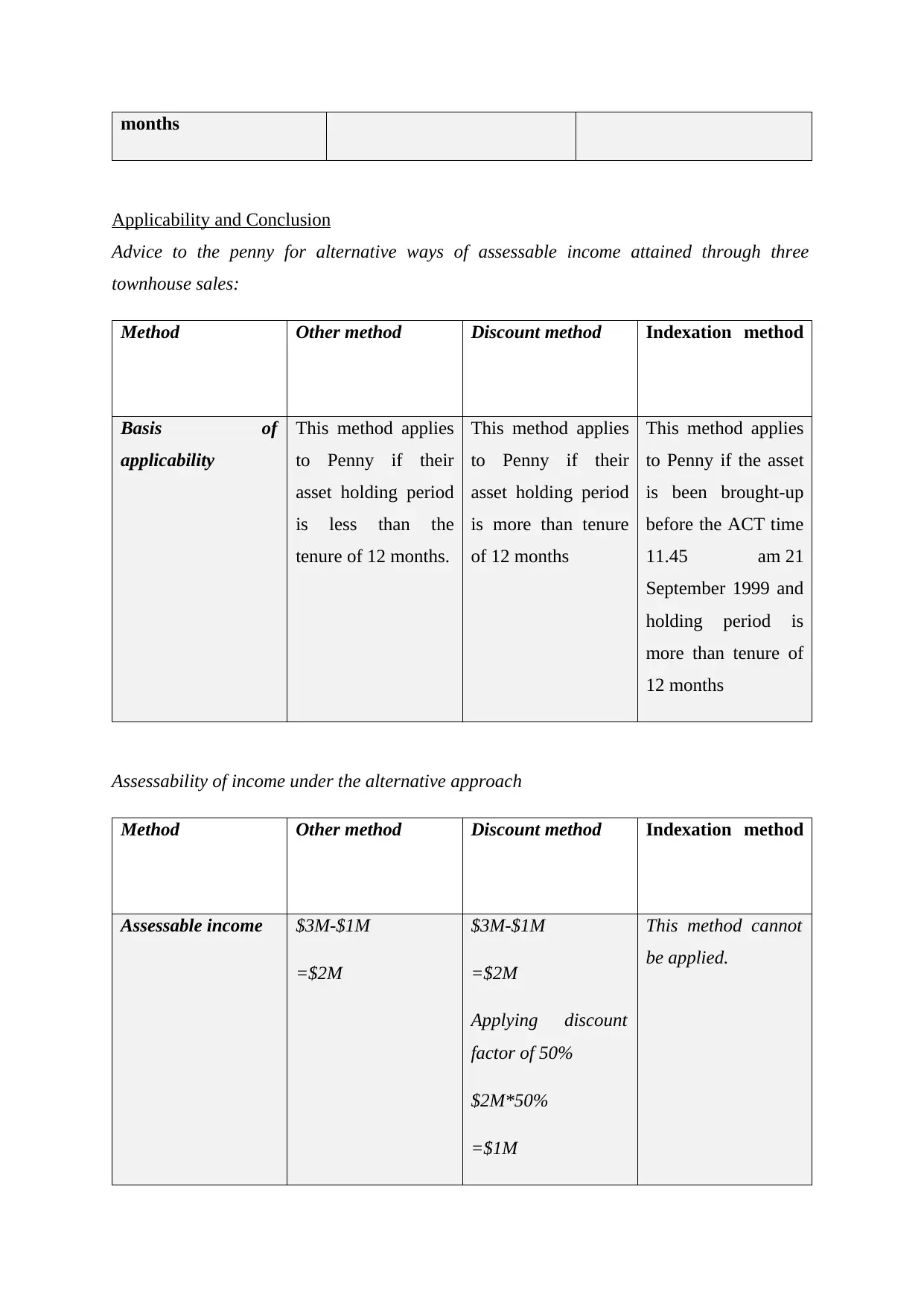
months
Applicability and Conclusion
Advice to the penny for alternative ways of assessable income attained through three
townhouse sales:
Method Other method Discount method Indexation method
Basis of
applicability
This method applies
to Penny if their
asset holding period
is less than the
tenure of 12 months.
This method applies
to Penny if their
asset holding period
is more than tenure
of 12 months
This method applies
to Penny if the asset
is been brought-up
before the ACT time
11.45 am 21
September 1999 and
holding period is
more than tenure of
12 months
Assessability of income under the alternative approach
Method Other method Discount method Indexation method
Assessable income $3M-$1M
=$2M
$3M-$1M
=$2M
Applying discount
factor of 50%
$2M*50%
=$1M
This method cannot
be applied.
Applicability and Conclusion
Advice to the penny for alternative ways of assessable income attained through three
townhouse sales:
Method Other method Discount method Indexation method
Basis of
applicability
This method applies
to Penny if their
asset holding period
is less than the
tenure of 12 months.
This method applies
to Penny if their
asset holding period
is more than tenure
of 12 months
This method applies
to Penny if the asset
is been brought-up
before the ACT time
11.45 am 21
September 1999 and
holding period is
more than tenure of
12 months
Assessability of income under the alternative approach
Method Other method Discount method Indexation method
Assessable income $3M-$1M
=$2M
$3M-$1M
=$2M
Applying discount
factor of 50%
$2M*50%
=$1M
This method cannot
be applied.
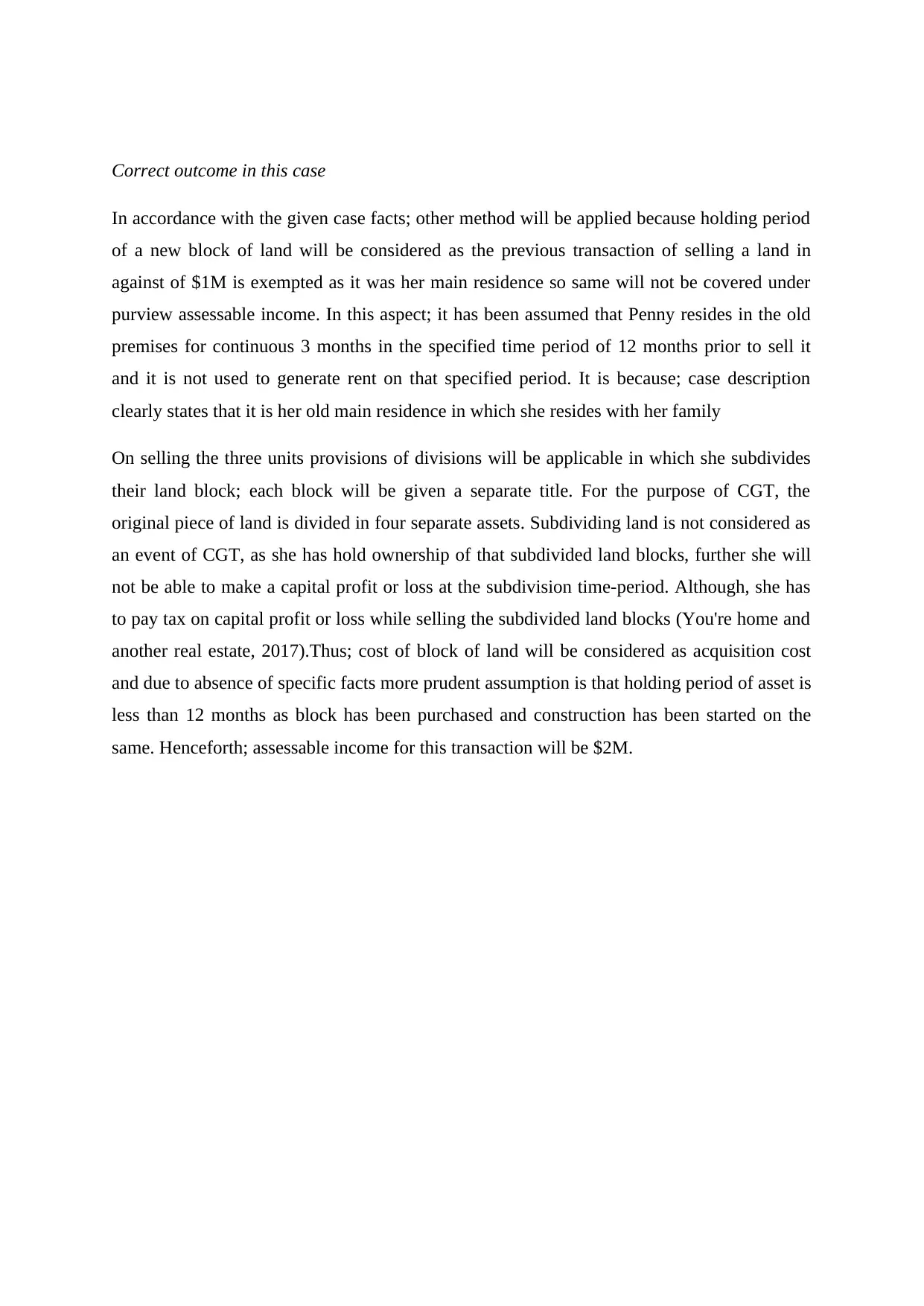
Correct outcome in this case
In accordance with the given case facts; other method will be applied because holding period
of a new block of land will be considered as the previous transaction of selling a land in
against of $1M is exempted as it was her main residence so same will not be covered under
purview assessable income. In this aspect; it has been assumed that Penny resides in the old
premises for continuous 3 months in the specified time period of 12 months prior to sell it
and it is not used to generate rent on that specified period. It is because; case description
clearly states that it is her old main residence in which she resides with her family
On selling the three units provisions of divisions will be applicable in which she subdivides
their land block; each block will be given a separate title. For the purpose of CGT, the
original piece of land is divided in four separate assets. Subdividing land is not considered as
an event of CGT, as she has hold ownership of that subdivided land blocks, further she will
not be able to make a capital profit or loss at the subdivision time-period. Although, she has
to pay tax on capital profit or loss while selling the subdivided land blocks (You're home and
another real estate, 2017).Thus; cost of block of land will be considered as acquisition cost
and due to absence of specific facts more prudent assumption is that holding period of asset is
less than 12 months as block has been purchased and construction has been started on the
same. Henceforth; assessable income for this transaction will be $2M.
In accordance with the given case facts; other method will be applied because holding period
of a new block of land will be considered as the previous transaction of selling a land in
against of $1M is exempted as it was her main residence so same will not be covered under
purview assessable income. In this aspect; it has been assumed that Penny resides in the old
premises for continuous 3 months in the specified time period of 12 months prior to sell it
and it is not used to generate rent on that specified period. It is because; case description
clearly states that it is her old main residence in which she resides with her family
On selling the three units provisions of divisions will be applicable in which she subdivides
their land block; each block will be given a separate title. For the purpose of CGT, the
original piece of land is divided in four separate assets. Subdividing land is not considered as
an event of CGT, as she has hold ownership of that subdivided land blocks, further she will
not be able to make a capital profit or loss at the subdivision time-period. Although, she has
to pay tax on capital profit or loss while selling the subdivided land blocks (You're home and
another real estate, 2017).Thus; cost of block of land will be considered as acquisition cost
and due to absence of specific facts more prudent assumption is that holding period of asset is
less than 12 months as block has been purchased and construction has been started on the
same. Henceforth; assessable income for this transaction will be $2M.
Secure Best Marks with AI Grader
Need help grading? Try our AI Grader for instant feedback on your assignments.
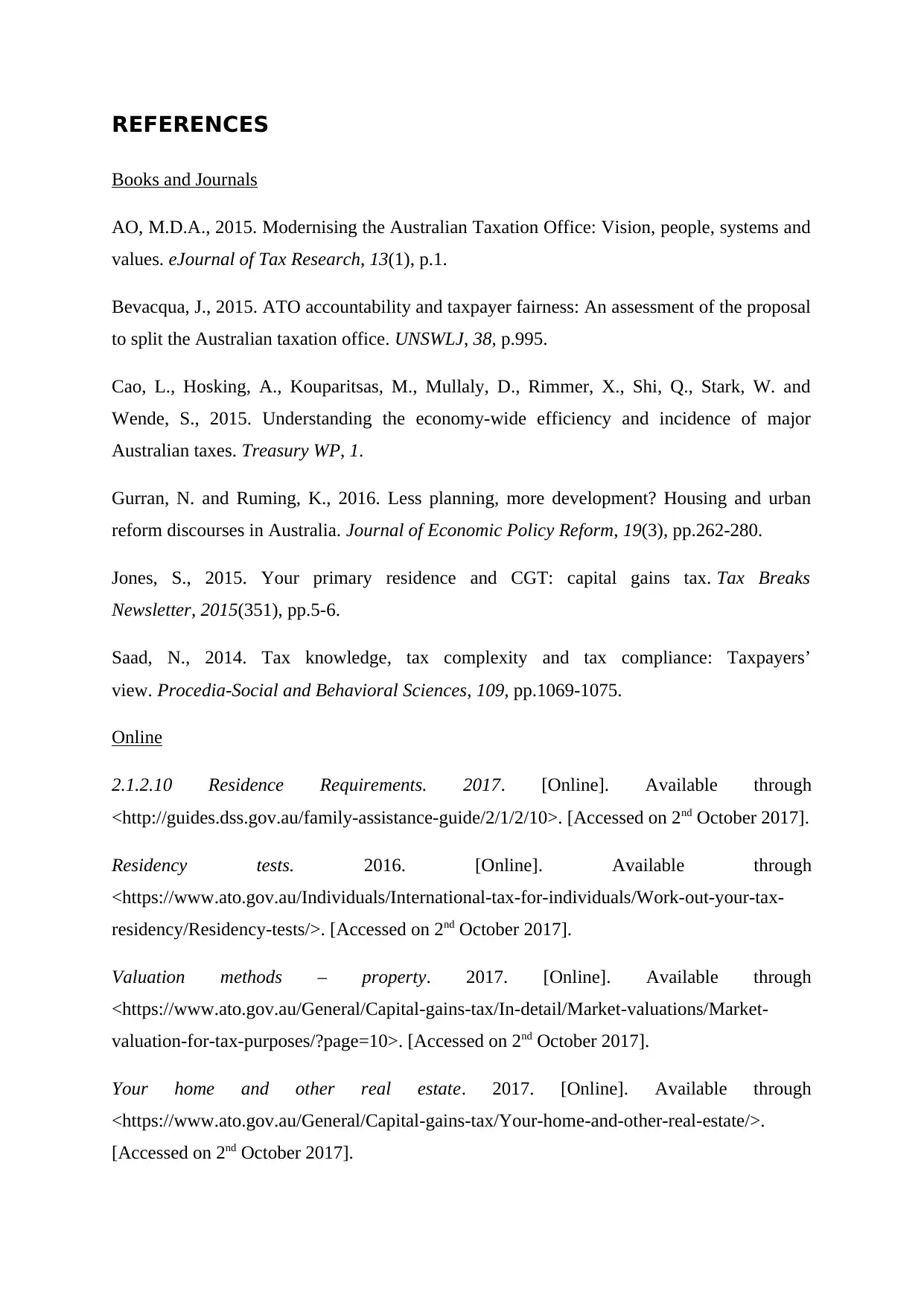
REFERENCES
Books and Journals
AO, M.D.A., 2015. Modernising the Australian Taxation Office: Vision, people, systems and
values. eJournal of Tax Research, 13(1), p.1.
Bevacqua, J., 2015. ATO accountability and taxpayer fairness: An assessment of the proposal
to split the Australian taxation office. UNSWLJ, 38, p.995.
Cao, L., Hosking, A., Kouparitsas, M., Mullaly, D., Rimmer, X., Shi, Q., Stark, W. and
Wende, S., 2015. Understanding the economy-wide efficiency and incidence of major
Australian taxes. Treasury WP, 1.
Gurran, N. and Ruming, K., 2016. Less planning, more development? Housing and urban
reform discourses in Australia. Journal of Economic Policy Reform, 19(3), pp.262-280.
Jones, S., 2015. Your primary residence and CGT: capital gains tax. Tax Breaks
Newsletter, 2015(351), pp.5-6.
Saad, N., 2014. Tax knowledge, tax complexity and tax compliance: Taxpayers’
view. Procedia-Social and Behavioral Sciences, 109, pp.1069-1075.
Online
2.1.2.10 Residence Requirements. 2017. [Online]. Available through
<http://guides.dss.gov.au/family-assistance-guide/2/1/2/10>. [Accessed on 2nd October 2017].
Residency tests. 2016. [Online]. Available through
<https://www.ato.gov.au/Individuals/International-tax-for-individuals/Work-out-your-tax-
residency/Residency-tests/>. [Accessed on 2nd October 2017].
Valuation methods – property. 2017. [Online]. Available through
<https://www.ato.gov.au/General/Capital-gains-tax/In-detail/Market-valuations/Market-
valuation-for-tax-purposes/?page=10>. [Accessed on 2nd October 2017].
Your home and other real estate. 2017. [Online]. Available through
<https://www.ato.gov.au/General/Capital-gains-tax/Your-home-and-other-real-estate/>.
[Accessed on 2nd October 2017].
Books and Journals
AO, M.D.A., 2015. Modernising the Australian Taxation Office: Vision, people, systems and
values. eJournal of Tax Research, 13(1), p.1.
Bevacqua, J., 2015. ATO accountability and taxpayer fairness: An assessment of the proposal
to split the Australian taxation office. UNSWLJ, 38, p.995.
Cao, L., Hosking, A., Kouparitsas, M., Mullaly, D., Rimmer, X., Shi, Q., Stark, W. and
Wende, S., 2015. Understanding the economy-wide efficiency and incidence of major
Australian taxes. Treasury WP, 1.
Gurran, N. and Ruming, K., 2016. Less planning, more development? Housing and urban
reform discourses in Australia. Journal of Economic Policy Reform, 19(3), pp.262-280.
Jones, S., 2015. Your primary residence and CGT: capital gains tax. Tax Breaks
Newsletter, 2015(351), pp.5-6.
Saad, N., 2014. Tax knowledge, tax complexity and tax compliance: Taxpayers’
view. Procedia-Social and Behavioral Sciences, 109, pp.1069-1075.
Online
2.1.2.10 Residence Requirements. 2017. [Online]. Available through
<http://guides.dss.gov.au/family-assistance-guide/2/1/2/10>. [Accessed on 2nd October 2017].
Residency tests. 2016. [Online]. Available through
<https://www.ato.gov.au/Individuals/International-tax-for-individuals/Work-out-your-tax-
residency/Residency-tests/>. [Accessed on 2nd October 2017].
Valuation methods – property. 2017. [Online]. Available through
<https://www.ato.gov.au/General/Capital-gains-tax/In-detail/Market-valuations/Market-
valuation-for-tax-purposes/?page=10>. [Accessed on 2nd October 2017].
Your home and other real estate. 2017. [Online]. Available through
<https://www.ato.gov.au/General/Capital-gains-tax/Your-home-and-other-real-estate/>.
[Accessed on 2nd October 2017].
1 out of 11
Related Documents
Your All-in-One AI-Powered Toolkit for Academic Success.
+13062052269
info@desklib.com
Available 24*7 on WhatsApp / Email
![[object Object]](/_next/static/media/star-bottom.7253800d.svg)
Unlock your academic potential
© 2024 | Zucol Services PVT LTD | All rights reserved.





